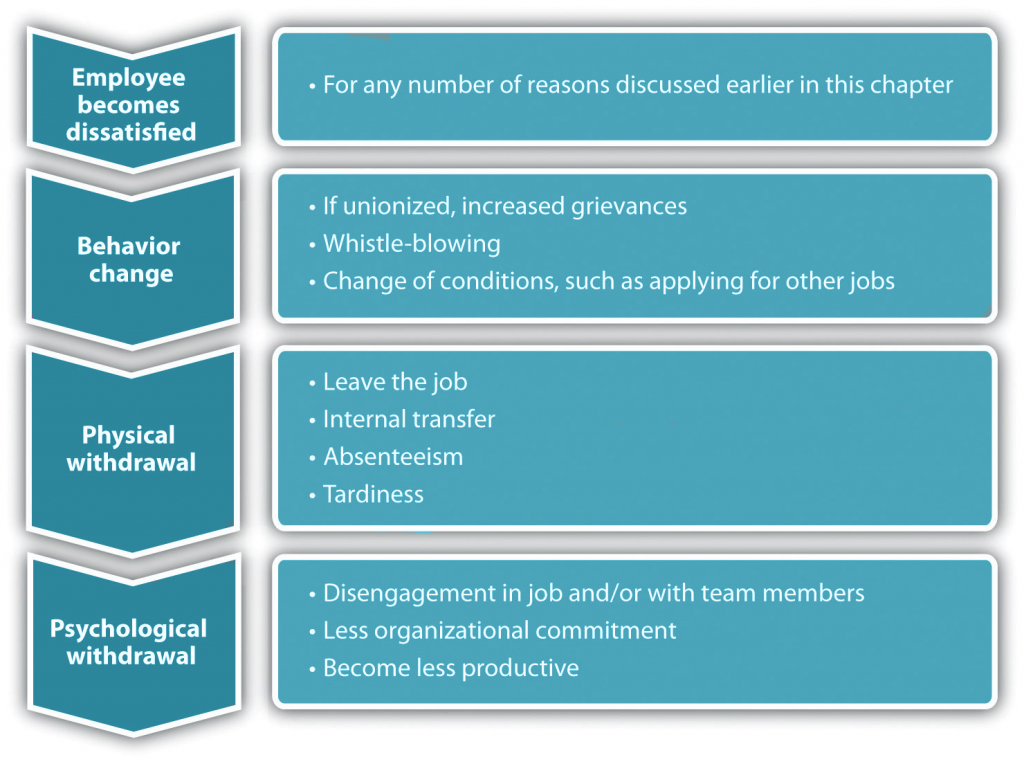4.4 Influencing Motivation at Work
Of course, the more motivated we are, the more likely we are to experience career success. Most, if not all, managers want to hire and promote people who show extensive motivation in their job. This is impossible to do if we do not first identify what actually motivates us as individuals. If you are motivated by intrinsic rewards, such as feeling good about your job, you are more likely to be better at your job because you enjoy it! Not only will we be better at our job if we like it, but it is highly likely we will be happier. When we are happier we tend to show better human relations skills, and this happiness can come in part from understanding our own motivations and making sure we choose a career path that matches with our motivations.
Theories on Job Dissatisfaction
There are a number of theories that attempt to describe what makes a satisfied employee versus a dissatisfied employee. Knowing what motivates us—and what doesn’t—is the key to choosing the right career path. It may be surprising, but much of what makes us satisfied or dissatisfied at work has little to do with money.
Progression of Job Withdrawal
Have you ever felt unhappy at a job? If you have, consider how you went through the process of being unhappy—because for most of us, we start out happy but then gradually become unhappy. One of the basic theories is the progression of job withdrawal theory, developed by Dan Farrell and James Petersen. It says that people develop a set of behaviors in order to avoid their work situation. These behaviors include behavior change, physical withdrawal, and psychological withdrawal.
Within the behavior change area, an employee will first try to change the situation that is causing the dissatisfaction. For example, if the employee is unhappy with the management style, he or she might consider asking for a department move. In the physical withdrawal phase, the employee does one of the following:
- Leaves the job
- Takes an internal transfer
- Starts to become absent or tardy
If an employee is unable to leave the job situation, he or she will experience psychological withdrawal. They will become disengaged and may show less job involvement and commitment to the organization, which can create large costs to the organization, such as dissatisfied customers, not to mention the cost to employee and his or her unhappiness in the job.
Often, our process of job withdrawal has to do with our lack of motivation.

Hawthorne Studies
Between 1927 and 1932, a series of experiments were conducted by Elton Mayo in the Western Electric Hawthorne Works company in Illinois. Mayo developed these experiments to see how the physical and environmental factors of the workplace, such as lighting and break times, would affect employee motivation.
This was some of the first research performed that looked at human motivation at work. His results were surprising, as he found that no matter which experiments were performed, worker output improved. His conclusion and explanation for this was the simple fact the workers were happy to receive attention from researchers who expressed interest in them. As a result, these experiments, scheduled to last one year, extended to five years to increase the knowledge base about human motivation.
The implication of this research applies to us as employees, even today. It tells us that our supervisors and managers should try to do things that make us feel valued. If not, we need to find ways to feel we add value to the organization.
Strategies Used to Increase Motivation
As we have addressed so far in this chapter, human motivation is an important aspect to understanding what makes us happy or unhappy at our jobs. Companies implement many strategies to keep us motivated at work. This section will discuss some of those specific strategies.
Salaries and Benefits
As we know from our earlier section, our paycheck can be a motivator to a certain extent. It is important to note that when we look at compensation, it is much more than only pay but things such as health benefits and paid time off.
Some of the considerations companies use surrounding pay can include the following:
- Instituting a standard process. Many organizations do not have set pay plans, which can result in unfairness when onboarding (the process of bringing someone “on board” with the company, including discussion and negotiation of compensation) or offering pay increases. Companies should make sure the process for receiving pay raises is fair and defensible, so as not to appear to be discriminatory.
- A pay communication strategy. Many companies work hard to make sure the fair pay process is communicated to employees. Transparency in the process of how raises are given and then communicated can help companies retain good employees (LeBlanc Group, 2010)
- Paid time off (PTO). Companies pay us not only with our salary but also from the time off we receive. Paid holidays and vacation time might be an example.
Training and Development
To meet our higher-level needs, we need to experience self-growth. As a result, many companies and managers offer training programs within the organization and pay for employees to attend career skill seminars and programs. It is a great idea to take advantage of these types of self-growth opportunities in your current or future organization. In addition, many companies offer tuition reimbursement programs to help you earn a degree. Dick’s Drive-In, a local fast food restaurant in Seattle, Washington, offers $28,000 in scholarships over four years to employees working twenty hours per week (Dick’s Drive-In, 2022). In a high turnover industry, Dick’s Drive-In boasts one of the highest employee retention rates around.
Performance Appraisals
The performance appraisal is a formalized process to assess how well an employee does his or her job. The effectiveness of this process can contribute to employee retention, in that we can gain constructive feedback on our job performance, and it can be an opportunity for the manager to work with the us to set goals within the organization. This process can help ensure our upper-level self-actualization needs are met, but it also can address some of the motivational factors discussed by Herzberg, such as achievement, recognition, and responsibility.
Succession Planning
Succession planning is a process of identifying and developing internal people who have the potential for filling positions. As we know, many people leave organizations because they do not see career growth or potential. Companies can combat this by having a clear career path for us to follow. For example, perhaps you start as a sales associate, become assistant manager, and then become manager. Proper succession planning shows what we must accomplish at each level in order to attain a higher-level position. This type of clear career path can help with our motivation at work. If your current or future organization does not have a succession plan, consider speaking with your manager about your own career path and potential. The performance appraisal process might be a good time to have this discussion.
Flextime, Telecommuting, and Sabbaticals
During the COVID-19 pandemic, many employees transitioned to remote work to comply with public health protocols. Moving forward, a flexible and remote work policy has been cited as an important strategy for employee retention (Wilson, 2021). According to a Salary.com survey, the ability to work from home and flexible work schedules are benefits that would entice us to stay in our job. In addition, some companies offer paid sabbaticals. The ability to implement this type of retention strategy might be difficult, depending on the type of business. For example, a retailer may not be able to implement this, since the sales associate must be in the store to assist customers. However, for many professions, it is a viable option, worth including in the retention plan and part of work-life balance.
Management Training
In a survey by the staffing firm, Robert Half in 2019 showed that 39% of Canadians interviewed for this study left their job because of behaviour from their managers. Micromanaging and taking a “hands-off” approach were common sources of frustration. Too much or too little involvement left employees feeling underappreciated and dissatisfied. Training of managers to be better communicators and motivators is a way to increase employee satisfaction and retention.
Conflict Management and Fairness
Perceptions on fairness and how organizations handle conflict can be a contributing factor to our motivation at work. Outcome fairness refers to the judgment that we make with respect to the outcomes we receive versus the outcomes received by others with whom we associate with. When we are deciding if something is fair, we will likely look at procedural justice, or the process used to determine the outcomes received. There are six main areas we use to determine the outcome fairness of a conflict:
- Consistency. We will determine if the procedures are applied consistently to other persons and throughout periods of time.
- Bias suppression. We perceive the person making the decision does not have bias or vested interest in the outcome.
- Information accuracy. The decision made is based on correct information.
- Correctability. The decision is able to be appealed and mistakes in the decision process can be corrected.
- Representativeness. We feel the concerns of all stakeholders involved have been taken into account.
- Ethicality. The decision is in line with moral societal standards.
For example, let’s suppose JoAnn just received a bonus and recognition at the company party for her contributions to an important company project. However, you might compare your inputs and outputs and determine it was unfair that JoAnn was recognized because you had worked on bigger projects and not received the same recognition or bonus. As you know from the last section, this type of unfairness can result in being unmotivated at work. Excellent communication with your manager when dealing with these types of situations would be imperative.
Job Design, Job Enlargement, and Empowerment
As we have discussed previously, one of the reasons for job dissatisfaction is the job itself. Ensuring our skills set and what we enjoy doing matches with the job is important. Some companies will use a change in job design, enlarge the job or empower employees to motivate them.
Job enrichment means to enhance a job by adding more meaningful tasks to make our work more rewarding. For example, if we as retail salespersons are good at creating eye-catching displays, allowing us to practice these skills and assignment of tasks around this could be considered job enrichment. Job enrichment can fulfill our higher level of human needs while creating job satisfaction at the same time. In fact, research in this area by Richard Hackman and Greg Oldham found that we, as employees, need the following to achieve job satisfaction:
- Skill variety, or many different activities as part of the job
- Task identity, or being able to complete one task from beginning to end
- Task significance, or the degree to which the job has impact on others, internally or externally
- Autonomy, or freedom to make decisions within the job
- Feedback, or clear information about performance
In addition, job enlargement, defined as the adding of new challenges or responsibilities to a current job, can create job satisfaction. Assigning us to a special project or task is an example of job enlargement.
Employee empowerment involves management allowing us to make decisions and act upon those decisions, with the support of the organization. When we are not micromanaged and have the power to determine the sequence of our own work day, we tend to be more satisfied than those employees who are not empowered. Empowerment can include the following:
- Encourage innovation or new ways of doing things.
- Make sure we, as employees, have the information we need to do our jobs; for example, we are not dependent on managers for information in decision making.
- Management styles that allow for participation, feedback, and ideas from employees.
Pay-for-Performance Strategies
Some organizations have a pay-for-performance strategy, which means that we are rewarded for meeting preset objectives within the organization. For example, in a merit-based pay system, we might be rewarded for meeting or exceeding performance during a given time period. Rather than a set pay increase every year, the increase is based on performance. Some organizations offer bonuses to employees for meeting objectives, while some organizations offer team incentive pay if a team achieves a specific, predetermined outcome.
Gain sharing, different from profit sharing, focuses on improvement of productivity within the organization. For example, the city of Loveland in Colorado implemented a gain-sharing program that defined three criteria that needed to be met for employees to be given extra compensation. The city revenues had to exceed expenses, expenses had to be equal to or less than the previous year’s expenses, and a citizen satisfaction survey had to meet minimum requirements.
As we have already addressed, pay isn’t everything, but it certainly can be an important part of feeling motivated in our jobs.
 Let’s Focus
Let’s Focus
Other Ways to Motivate Employees
According to Fortune’s “100 Best Companies to Work For” (CNN Money, 2011) things that companies do to motivate us may be more unusual. For example, the list includes the following:
- On-site daycare or daycare assistance
- Gym memberships or on-site gyms
- Concierge service to assist in party planning or dog grooming, for example
- On-site dry cleaning drop-off and pickup
- Car care, such as oil changes, on-site once a week
- On-site doggie daycare
- On-site yoga or other fitness classes
- “Summer Fridays,” when all employees work half days on Fridays during the summer
- Various support groups for cancer survivors, weight loss, or support in caring for aging parents
- On-site life coaches
- Peer-to-peer employee recognition programs
- Management recognition programs
While some of these options may not be options in the companies we work for, the important thing to remember is often our own motivation comes from us internally. As a result, we need to be aware of our changing motivations and ask for those things that could make us more motivated at work.
 Let’s Review
Let’s Review
- Salary and benefits are a major component of what employers do to motivate us. Consistent pay systems and transparent processes are important considerations.
- Many companies offer paid tuition programs, reimbursement programs, and in-house training to increase our skills and knowledge.
- Performance appraisals provide an avenue for feedback and goal setting. They also allow for us to be recognized for our contributions.
- Succession plans allow us, as employees, the ability to see how we can continue our career with the organization, and they clearly detail what we need to do to achieve career growth.
- Flextime and telecommuting are options some companies use as motivators. These types of plans allow us flexibility when developing our schedule and some control of our work. Some companies also offer paid or unpaid sabbaticals to pursue personal interests after a certain number of years with the company.
- Since one of the reasons people are dissatisfied at their job is because of the relationship with their manager, many companies require management training and communication training to ensure managers are able to establish good relationships with employees.
- Some companies may change the job through empowerment or job enlargement to help grow our skills.
- Other, more unique ways companies try to retain employees might include offering services to make the employee’s life easier, such as dry cleaning, daycare services, or on-site yoga classes.
 Case Study
Case Study
See Appendix A – Motivating Employees: The Case of Canada’s Shopify
 Exercise
Exercise
- Research two different companies you might be interested in working for. When reviewing their list of benefits, which ones are offered that might motivate you to stay with the organization?
References
This section was adapted from:
Human Relations by Saylor Academy under a Creative Commons Attribution-NonCommercial-ShareAlike 3.0 License without attribution as requested by the work’s original creator or licensor.
CNN Money. (2011). Fortune’s 100 best companies to work for. Retrieved February 26, 2011, http://money.cnn.com/galleries/2011/news/companies/1101/gallery.bestcompanies_unusual_perks.fortune/5.html.
Dick’s Drive-In. (2022). Working at Dick’s is a family affair. Retrieved April 14, 2022, https://www.ddir.com/employment/#:~:text=All%20employees%20have%20access%20to,vocational%20or%20self%2Dimprovement%20program.
Farrell, D., & Petersen, J. C. (1984). Commitment, absenteeism and turnover of new employees: A longitudinal study. Human Relations, 37(8), 681–92.
Salary.com. (2008). Employee job satisfaction and retention survey, 2007/2008. Retrieved February 26, 2011, http://www.salary.com/docs/resources/JobSatSurvey_08.pdf.
Elton Mayo (2007). The social problems of an industrial civilization. Arno Press. (Originally published in 1949).
WorldatWork and The LeBlanc Group LLC. (2010). The knowledge of pay study. Retrieved February 26, 2011, http://www.worldatwork.org/waw/Content/research/html/research-home.jsp.
Wilson, J. (2019). Two-in-five workers in Canada have quit due to a bad boss survey reveals. Robert Half. Retrieved February 11, 2022, https://www.roberthalf.ca/en/two-in-five-workers-in-canada-have-quit-due-to-a-bad-boss-survey-reveals

